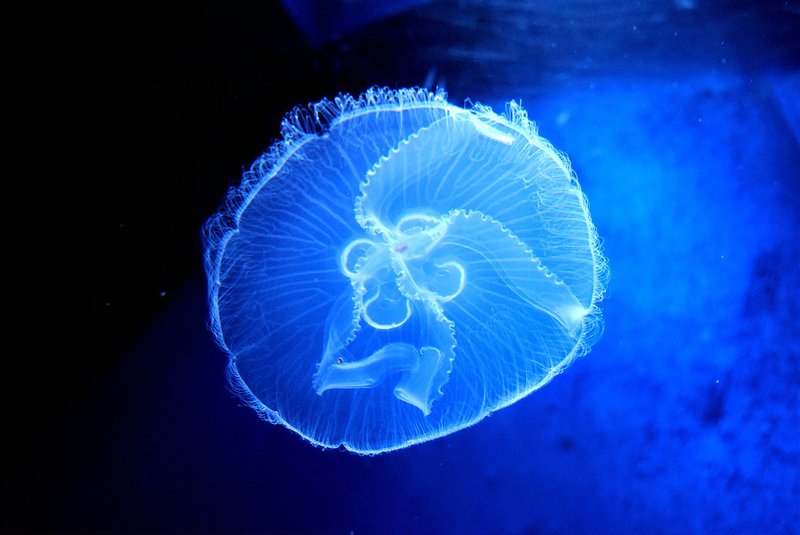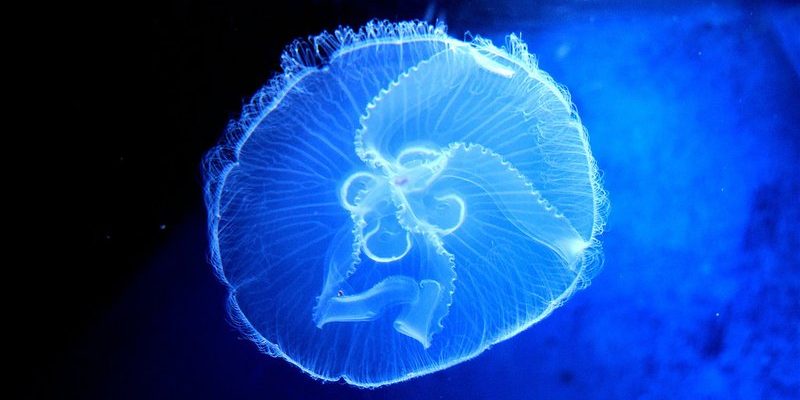
Imagine the Moon Jellyfish as the ocean’s gentle ballerina. They drift gracefully through the water, pulsating with a rhythm that’s both mesmerizing and calming. Yet, beneath their tranquil appearance, these creatures have some surprising secrets! Let’s dive into ten cool facts about the Moon Jellyfish that you probably didn’t know, and discover why they’re such an essential part of marine life.
1. Moon Jellyfish Are Mostly Water
You might be surprised to learn that the Moon Jellyfish is made up of about 95% water! This high water content gives them their delicate, squishy appearance. It’s almost like their body is a jelly-like bag filled with seawater, making them incredibly light. Because of this, they don’t have bones, blood, or a brain. Instead, their simple structure allows them to float effortlessly in the ocean currents.
This simplicity is key to their survival. They don’t need a lot of energy to thrive. Instead, they rely on the currents to bring them food. The ocean provides their meals, which mainly consist of tiny plankton and fish larvae. As they drift through the sea, they catch their food using stinging cells called cnidocytes, which they use to paralyze their prey.
2. They Have a Mesmerizing Life Cycle
Life for a Moon Jellyfish doesn’t start as a jellyfish. Instead, they begin as tiny larvae called planulae. These planulae eventually settle on a surface, where they transform into polyps. This is where the real magic happens! The polyp undergoes a process called budding, creating small jellyfish clones that eventually break free and start their own journey.
You might be wondering how long this process takes. It can vary, but typically, a Moon Jellyfish can go from a polyp to a free-swimming jelly in just a few weeks. It’s fascinating to think that one tiny larva can lead to a whole swarm of jellyfish floating together, isn’t it?
3. Colorful Contrasts: They Glow in the Dark
While the Moon Jellyfish is usually a pale, almost transparent color, did you know they can emit a soft glow? This bioluminescence allows them to light up the dark ocean depths, like tiny stars twinkling in the water. This glow isn’t just for show; it plays a role in communication and attracting mates.
This ability to glow can also serve as a defense mechanism. When threatened, some jellyfish can produce a flash of light to distract predators and give them a chance to escape. Talk about a clever survival tactic!
4. They’re Not Dangerous to Humans
You may have heard stories about jellyfish stings, but here’s the good news: the Moon Jellyfish is mostly harmless to humans. Their stinging cells are generally too weak to penetrate human skin. If you do get stung, it might feel like a light tickle or irritation, but it’s usually not serious.
However, that doesn’t mean all jellyfish are safe! Some species have powerful stings that can cause serious harm. So, if you’re swimming in the ocean and spot a Moon Jellyfish, feel free to look but keep your distance. They’re beautiful to observe, but it’s always best to respect their space!
5. They Can Be Found All Over the World
One of the coolest things about the Moon Jellyfish is their adaptability. These jellyfish are found in oceans worldwide, from the warm, tropical waters to the chilly Arctic seas. They tend to thrive in areas where food is plentiful, making them a common sight in coastal regions.
Their ability to live in different environments means that they can adapt to changing conditions. Climate change and pollution can impact jellyfish populations, but they often bounce back quickly due to their resilient nature. It’s a reminder of how interconnected our oceans are!
6. They Contribute to the Marine Ecosystem
Moon Jellyfish play an important role in the marine food web. They aren’t just drifting around for fun; they’re vital contributors to the ecosystem. As predators, they help control plankton populations, which can influence the health of the ocean.
Moreover, when jellyfish die, they decompose and provide nutrients back into the water, supporting other marine life. Think of them as a natural recycling system! Their presence can also indicate the health of ocean environments, helping scientists monitor changes in marine ecosystems.
7. They’re Part of the Art World
Moon Jellyfish have caught the attention of artists and photographers alike. Their ethereal beauty and graceful movements make them a popular subject for art and photography. Many aquariums showcase them in stunning displays with colorful lights that enhance their natural glow.
In fact, some artists have even used jellyfish as inspiration for their sculptures and paintings. Their flowing shapes and soft colors evoke a sense of tranquility, and people often find watching them to be a peaceful experience. Have you ever spent time just admiring their movements? It’s mesmerizing!
8. They Can Live Longer Than You Think
While Moon Jellyfish might look delicate, they can actually live for several years in the right conditions. In the wild, they typically have a lifespan of 1-3 years, but in aquariums, they can occasionally live longer with proper care.
The length of their life often depends on environmental factors, such as food availability and water quality. It’s interesting to think that these seemingly fragile creatures have resilience and can adapt to their surroundings!
9. Jellyfish Are Ancient Creatures
Moon Jellyfish have been around for a long time—over 500 million years! They are some of the oldest living creatures on Earth. This long history has seen them survive multiple mass extinctions and changes in the planet’s climate.
Their ability to adapt over millions of years speaks to the resilience of life and how certain species can thrive despite changing conditions. It’s a fascinating reminder of how interconnected all living things are and how history shapes our current world.
10. The Moon Jellyfish Is a Cultural Icon
In some cultures, Moon Jellyfish are seen as symbols of peace and tranquility. Their graceful movements and gentle nature have made them a favorite in various forms of art, literature, and even tattoos. People often associate them with calmness and serenity, making them a popular motif for those seeking a reminder to go with the flow in life.
Their presence can evoke feelings of stillness, allowing people to reflect on their own experiences. So, if you ever find yourself feeling overwhelmed, take a moment to think about the Moon Jellyfish and their peaceful journey through the ocean.
As you can see, the Moon Jellyfish isn’t just a beautiful creature drifting aimlessly in the sea. They have a fascinating life cycle, contribute to their ecosystem, and play a unique role in human culture. Next time you see one, remember it’s not just a jellyfish; it’s a tiny piece of history floating through our oceans!

